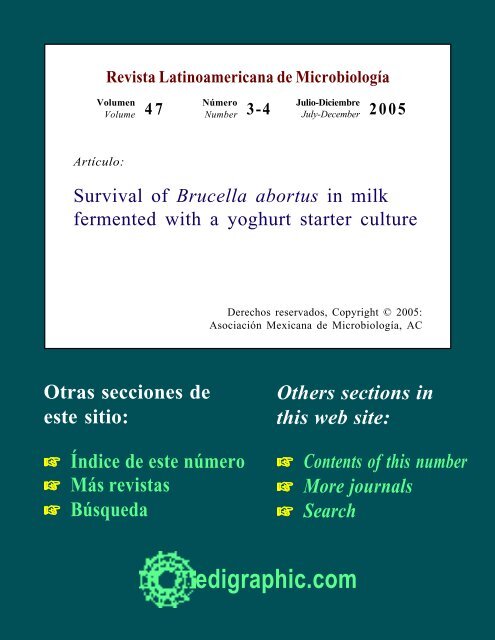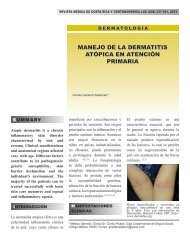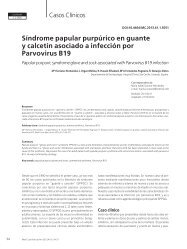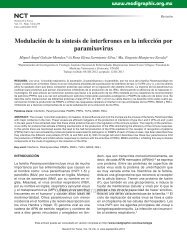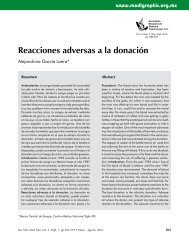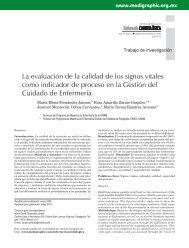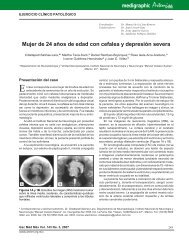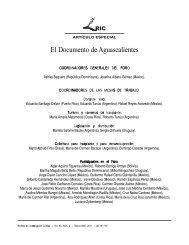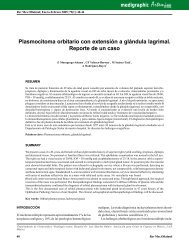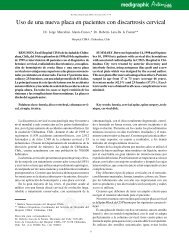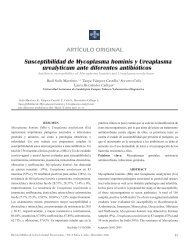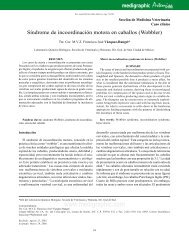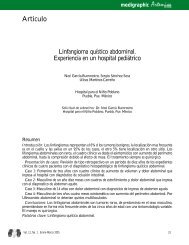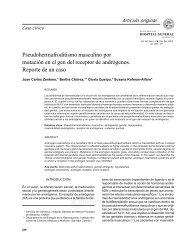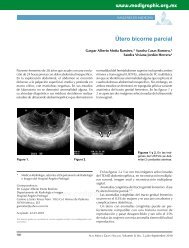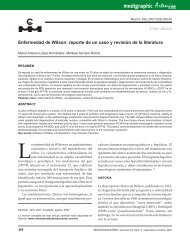Survival of Brucella abortus in milk fermented with ... - edigraphic.com
Survival of Brucella abortus in milk fermented with ... - edigraphic.com
Survival of Brucella abortus in milk fermented with ... - edigraphic.com
Create successful ePaper yourself
Turn your PDF publications into a flip-book with our unique Google optimized e-Paper software.
Artículo:<br />
Revista Lat<strong>in</strong>oamericana de Microbiología<br />
Volumen<br />
Volume 47<br />
Otras secciones de<br />
este sitio:<br />
Número<br />
Number 3-4<br />
<strong>Survival</strong> <strong>of</strong> <strong>Brucella</strong> <strong>abortus</strong> <strong>in</strong> <strong>milk</strong><br />
<strong>fermented</strong> <strong>with</strong> a yoghurt starter culture<br />
! Índice de este número<br />
! Más revistas<br />
! Búsqueda<br />
Julio-Diciembre<br />
July-December 2005<br />
Derechos reservados, Copyright © 2005:<br />
Asociación Mexicana de Microbiología, AC<br />
Others sections <strong>in</strong><br />
this web site:<br />
! Contents <strong>of</strong> this number<br />
! More journals<br />
! Search<br />
<strong>edigraphic</strong>.<strong>com</strong>
Revista Lat<strong>in</strong>oamericana de<br />
MICROBIOLOGÍA<br />
Vol. 47, No. 3-4<br />
July - September. 2005<br />
October - December. 2005<br />
pp. 88 - 91<br />
REVIEW ARTICLE<br />
<strong>Survival</strong> <strong>of</strong> <strong>Brucella</strong> <strong>abortus</strong> <strong>in</strong> <strong>milk</strong> <strong>fermented</strong> <strong>with</strong><br />
a yoghurt starter culture<br />
Armida Zúñiga Estrada,* , ** Lydia Mota de la Garza,* Miroslava Sánchez Mendoza,* Eva María<br />
Santos López,** Santiago Filardo Kerstupp,** Ahidé López Mer<strong>in</strong>o*<br />
ABSTRACT. In countries such as Mexico, brucellosis is still an important<br />
public health problem due to the consumption <strong>of</strong> non-pasteurized<br />
<strong>milk</strong> and dairy products, contam<strong>in</strong>ated <strong>with</strong> <strong>Brucella</strong> spp. The<br />
aim <strong>of</strong> this study was to look <strong>in</strong>to the survival <strong>of</strong> <strong>Brucella</strong> <strong>abortus</strong><br />
dur<strong>in</strong>g fermentation <strong>of</strong> <strong>milk</strong> <strong>with</strong> a yoghurt starter culture and storage<br />
at refrigeration temperature. Sterile skim <strong>milk</strong> was <strong>in</strong>oculated <strong>with</strong> B.<br />
<strong>abortus</strong> at two concentrations, 10 5 and 10 8 CFU/ml simultaneously<br />
<strong>with</strong> a yoghurt starter culture <strong>of</strong> lactic acid bacteria (Streptococcus<br />
thermophilus and Lactobacillus delbrueckii subspecie bulgaricus).<br />
Inoculated flasks were <strong>in</strong>cubated at 42ºC, followed by refrigeration<br />
at 4ºC. Samples were taken dur<strong>in</strong>g fermentation and dur<strong>in</strong>g storage<br />
and viable count <strong>of</strong> B. <strong>abortus</strong> and lactic acid bacteria and pH were<br />
determ<strong>in</strong>ed. Results showed that after 10 days <strong>of</strong> storage at 4°C, B.<br />
<strong>abortus</strong> was recovered <strong>in</strong> <strong>fermented</strong> <strong>milk</strong> at a level <strong>of</strong> 10 5 CFU/ml,<br />
despite the low pH below 4.0. Therefore B. <strong>abortus</strong> is able to survive<br />
<strong>in</strong> <strong>fermented</strong> <strong>milk</strong>. This f<strong>in</strong>d<strong>in</strong>g may imply that non-pasteurized<br />
<strong>fermented</strong> <strong>milk</strong> contam<strong>in</strong>ated <strong>with</strong> <strong>Brucella</strong> <strong>abortus</strong> could be a<br />
means <strong>of</strong> transmission <strong>of</strong> these bacteria.<br />
Key words: <strong>Brucella</strong> spp, <strong>Brucella</strong> <strong>abortus</strong>, <strong>fermented</strong> <strong>milk</strong>, survival,<br />
yoghurt.<br />
INTRODUCTION<br />
Brucellosis is a zoonotic disease <strong>of</strong> worldwide distribution<br />
that ma<strong>in</strong>ly affects people <strong>in</strong> contact <strong>with</strong> domestic animals<br />
and animal products. Although the disease is be<strong>in</strong>g<br />
controlled <strong>in</strong> many developed countries, it still rema<strong>in</strong>s endemic<br />
<strong>in</strong> many parts <strong>of</strong> the world, <strong>in</strong>clud<strong>in</strong>g Lat<strong>in</strong> America,<br />
the Middle East, Spa<strong>in</strong>, Africa, and western Asia. 4,5,14,15,22,24<br />
The disease is ma<strong>in</strong>ly transmitted to humans through the <strong>in</strong>gestion<br />
<strong>of</strong> raw <strong>milk</strong> or non-pasteurized cheese contam<strong>in</strong>ated<br />
<strong>with</strong> one <strong>of</strong> the four <strong>Brucella</strong> species pathogenic to humans.<br />
6,19,20 Brucellosis <strong>in</strong> dairy cattle is very important <strong>in</strong><br />
countries such as Mexico, where the <strong>in</strong>cidence has fluctuated<br />
between 4-11% dur<strong>in</strong>g the last years. 11-14<br />
Local food habits, like the consumption <strong>of</strong> unpasteurized<br />
dairy products, have led to epidemic outbreaks <strong>of</strong> hu-<br />
* Departamento de Microbiología. Escuela Nacional de Ciencias Biológicas. Instituto<br />
Politécnico Nacional. Apartado Postal 4-870. 06400 México, D.F.<br />
** Centro de Investigaciones Químicas. Universidad Autónoma del Estado de Hidalgo.<br />
42076 Pachuca, Hidalgo, México.<br />
Received April 21, 2005; received <strong>in</strong> revised form August 24, 2005; accepted October<br />
4, 2005.<br />
RESUMEN. En países <strong>com</strong>o México la brucelosis representa un importante<br />
problema de Salud Pública debido pr<strong>in</strong>cipalmente al consumo<br />
de leche y productos lácteos no pasteurizados contam<strong>in</strong>ados con<br />
<strong>Brucella</strong> spp. El objetivo de este estudio fue determ<strong>in</strong>ar la sobrevivencia<br />
de <strong>Brucella</strong> <strong>abortus</strong> en leche <strong>in</strong>oculada con un cultivo <strong>in</strong>iciador<br />
para elaborar yogur, fermentada a 42ºC y posteriormente refrigerada.<br />
La leche descremada estéril se <strong>in</strong>oculó con el cultivo <strong>in</strong>iciador<br />
para elaborar yogur formado por Streptococcus thermophillus y Lactobacillus<br />
delbrueckii subespecie bulgaricus, simultáneamente con<br />
B. <strong>abortus</strong> a dos diferentes concentraciones, 10 5 and 10 8 UFC/ml.<br />
Se tomaron muestras durante la fermentación y durante el almacenamiento,<br />
en las cuales se determ<strong>in</strong>ó cuenta viable de B. <strong>abortus</strong>,<br />
así <strong>com</strong>o de S. thermophillus y L. delbrueckii; también se determ<strong>in</strong>ó<br />
el pH. Los resultados mostraron que B. <strong>abortus</strong> fue capaz de sobrevivir<br />
hasta 10 días en leche fermentada y almacenada a 4ºC, a<br />
pesar de que el pH fue de alrededor de 4.0. Por tanto, la leche fermentada<br />
no pasteurizada y contam<strong>in</strong>ada con <strong>Brucella</strong> <strong>abortus</strong> puede<br />
ser vehículo para la transmisión de esta bacteria.<br />
Palabras clave: <strong>Brucella</strong> spp, <strong>Brucella</strong> <strong>abortus</strong>, leche fermentada,<br />
sobrevivencia, yogur.<br />
man illness. 1-3,5,12,16,18,23 In 1997, dairy products accounted<br />
for 84% <strong>of</strong> the sources <strong>of</strong> <strong>in</strong>fection <strong>of</strong> human brucellosis<br />
(40% <strong>milk</strong>, 40% cheese, 4% other dairy products, and 5%<br />
were occupational cases <strong>in</strong> Mexico. 11<br />
The survival <strong>of</strong> <strong>Brucella</strong> <strong>in</strong> non <strong>fermented</strong> dairy products<br />
has been <strong>in</strong>vestigated by some authors, who have<br />
demonstrated that <strong>Brucella</strong> spp. was able to survive for<br />
periods as long as 18 months; however there is little<br />
<strong>in</strong>formation published about the survival <strong>of</strong> B. <strong>abortus</strong> <strong>in</strong><br />
<strong>fermented</strong> <strong>milk</strong> food. 7,10,21<br />
To understand the role <strong>of</strong> yoghurt as a vehicle for transmitt<strong>in</strong>g<br />
B. <strong>abortus</strong>, a research study was carried out on the<br />
behavior <strong>of</strong> this pathogen dur<strong>in</strong>g sterilized skim <strong>milk</strong> fermentation<br />
<strong>with</strong> a yoghurt starter culture and subsequent<br />
storage at refrigeration temperature.<br />
<strong>edigraphic</strong>.<strong>com</strong><br />
MATERIAL AND METHODS<br />
Stra<strong>in</strong>s. B. <strong>abortus</strong> biovar 1 stra<strong>in</strong> 544 ATCC 23448,<br />
NCTC 10093 was grown <strong>in</strong> sterilized skim <strong>milk</strong> at 12%<br />
(SSM, Difco) and <strong>in</strong>cubated 48 hours at 37ºC under a 6%<br />
CO 2 atmosphere. Culture counts were performed on Farrell’s<br />
agar plates (Oxoid) us<strong>in</strong>g tryptose soy broth as diluent.
Zúñiga et al <strong>Survival</strong> <strong>of</strong> <strong>Brucella</strong> <strong>abortus</strong> <strong>in</strong> <strong>milk</strong> <strong>fermented</strong> <strong>with</strong> a yoghurt starter culture<br />
Rev Lat<strong>in</strong>oam Microbiol 2005; 47 (3-4): 88-91<br />
Starter culture. A lyophilized yoghurt :rop odarobale starter culture FDP<br />
obta<strong>in</strong>ed <strong>in</strong> our laboratory from natural <strong>fermented</strong> dairy<br />
products, <strong>com</strong>posed <strong>of</strong> VC a 1:1 ed AS, mix cidemihparG<br />
<strong>of</strong> Streptococcus salivarius<br />
subsp. thermophilus and Lactobacillus delbrueckii<br />
subspecie bulgaricus was used. Work<strong>in</strong>g arap lactic cultures<br />
were prepared mix<strong>in</strong>g 0.1 g <strong>of</strong> the starter culture and 10 ml<br />
<strong>of</strong> SSM and acidémoiB <strong>in</strong>cubated arutaretiL 8 hours at :cihpargideM<br />
42ºC. Therefore 2% (v/v)<br />
<strong>in</strong>oculum was mixed <strong>with</strong> 200 ml <strong>of</strong> SSM and <strong>in</strong>cubated<br />
under sustraídode-m.e.d.i.g.r.a.p.h.i.c<br />
the same conditions. This procedure was performed<br />
twice to obta<strong>in</strong> the activated work<strong>in</strong>g culture.<br />
Microbiological assays. Assays were performed <strong>in</strong> duplicate<br />
<strong>with</strong> concentrations <strong>of</strong> 1 x 105 or 1 x 108 CFU <strong>of</strong> B.<br />
<strong>abortus</strong> per ml <strong>of</strong> <strong>milk</strong>. One set <strong>of</strong> five flasks conta<strong>in</strong><strong>in</strong>g<br />
200 ml <strong>of</strong> SSM was used for each concentration <strong>of</strong> the<br />
pathogen. Three flasks were <strong>in</strong>oculated <strong>with</strong> a B. <strong>abortus</strong><br />
suspension to obta<strong>in</strong> the desired concentration; two <strong>of</strong><br />
these flasks were also <strong>in</strong>oculated <strong>with</strong> the yoghurt starter<br />
culture (106 CFU <strong>of</strong> lactic acid bacteria/ml <strong>of</strong> <strong>milk</strong>); the<br />
one that only conta<strong>in</strong>ed B. <strong>abortus</strong> was considered the<br />
pathogen control. A fourth flask was <strong>in</strong>oculated only <strong>with</strong><br />
the yoghurt starter culture (starter culture control) and the<br />
fifth one was not <strong>in</strong>oculated (negative control).<br />
All flasks were <strong>in</strong>cubated at 42ºC for 8 h; thereafter<br />
they were stored at 4ºC. Samples were taken at 2 h <strong>in</strong>tervals<br />
dur<strong>in</strong>g fermentation and every 2 days dur<strong>in</strong>g storage;<br />
they were diluted <strong>in</strong> peptone water (Oxoid) and plated <strong>in</strong><br />
duplicate on Lactobacillus-Streptococcus Differential<br />
agar (LSD) for colony count<strong>in</strong>g <strong>of</strong> lactic acid bacteria and<br />
on Farrell’s agar (Oxoid) for counts <strong>of</strong> B. <strong>abortus</strong>. LSD<br />
agar is a selective medium which provides good growth<br />
and the differentiation <strong>of</strong> thermophilic lactobacilli and<br />
streptococci <strong>in</strong> yoghurt products; it was prepared<br />
accord<strong>in</strong>g to the formulation <strong>of</strong> Eloy and Lacrosse. 9 All<br />
plates were <strong>in</strong>cubated 48 h at 37ºC under a 6% CO2 atmosphere. Samples were taken until the pathogen was<br />
not detected <strong>in</strong> two consecutive sampl<strong>in</strong>gs. The pH <strong>of</strong><br />
the <strong>milk</strong> samples was measured <strong>with</strong> a pH meter<br />
equipped <strong>with</strong> a <strong>com</strong>b<strong>in</strong>ed electrode.<br />
RESULTS<br />
Figure 1 shows the behavior <strong>of</strong> B. <strong>abortus</strong> <strong>in</strong> <strong>milk</strong> <strong>in</strong>oculated<br />
<strong>with</strong> 1 x 10 5 CFU per ml dur<strong>in</strong>g fermentation at<br />
42ºC. Growth <strong>of</strong> the lactic culture was similar <strong>in</strong> the absence<br />
or presence <strong>of</strong> the pathogen. For this reason, <strong>in</strong> Figures<br />
1 to 4, only growth <strong>of</strong> S. salivarius subsp. thermo-<br />
philus and L. delbrueckii subspecie bulgaricus <strong>in</strong> the<br />
starter culture control flask is shown. After 8 h <strong>of</strong> <strong>in</strong>cubation,<br />
a slight growth <strong>of</strong> B. <strong>abortus</strong> close to one logarithm<br />
<strong>of</strong> magnitude, <strong>in</strong> the pathogen control flask was observed,<br />
whereas <strong>in</strong> the flask conta<strong>in</strong><strong>in</strong>g B. <strong>abortus</strong> and the starter<br />
culture, no growth <strong>of</strong> the former was observed.<br />
<strong>edigraphic</strong>.<strong>com</strong><br />
89<br />
After the fermentation phase, the B. <strong>abortus</strong> population<br />
decreased after the first day <strong>of</strong> storage at 4°C; and after 10<br />
days no colony on agar plates was observed (Fig. 2). On<br />
the other hand, B. <strong>abortus</strong> population <strong>in</strong> the pathogen control<br />
flask did not show any variation dur<strong>in</strong>g 12 days. Lactic<br />
acid bacteria counts did not change <strong>with</strong> storage.<br />
The behavior <strong>of</strong> B. <strong>abortus</strong> <strong>in</strong>oculated at 1 x 10 8 CFU/<br />
ml <strong>of</strong> <strong>milk</strong> dur<strong>in</strong>g the fermentation phase is shown <strong>in</strong> Figure<br />
3. When B. <strong>abortus</strong> was <strong>in</strong>cubated together <strong>with</strong> the<br />
starter culture, its population did not change after 8 hours<br />
<strong>of</strong> <strong>in</strong>cubation; whereas <strong>in</strong> the absence <strong>of</strong> the starter culture,<br />
a slight <strong>in</strong>crease <strong>in</strong> B. <strong>abortus</strong> population was observed.<br />
Iog CFU/ml<br />
10<br />
9<br />
8<br />
7<br />
6<br />
5<br />
4<br />
3<br />
0 2 4 6 8<br />
Time (hours)<br />
Figure 1. Counts <strong>of</strong> S. salivarius subsp. thermophilus ( ), L. delbrueckii<br />
subsp. bulgaricus ( ), B. <strong>abortus</strong> when <strong>in</strong>cubated <strong>with</strong> the starter culture<br />
( ), B. <strong>abortus</strong> <strong>in</strong> the pathogen control ( ) and pH values ( )<br />
dur<strong>in</strong>g <strong>milk</strong> fermentation at 42°C <strong>with</strong> an <strong>in</strong>itial concentration <strong>of</strong> B. <strong>abortus</strong><br />
<strong>of</strong> 10 5 CFU/ml.<br />
.<br />
Iog CFU/ml<br />
10<br />
9<br />
8<br />
8<br />
7<br />
7<br />
6<br />
5<br />
6<br />
4<br />
3<br />
5<br />
2<br />
1<br />
4<br />
0<br />
3<br />
0 2 4 6<br />
Time (days)<br />
8 10 12<br />
Figure 2. Counts <strong>of</strong> S. salivarius subsp. thermophilus ( ), L. delbrueckii<br />
subsp. bulgaricus ( ), B. <strong>abortus</strong> when <strong>in</strong>cubated <strong>with</strong> the starter culture<br />
( ), B. <strong>abortus</strong> <strong>in</strong> the pathogen control ( ) and pH values ( ) dur<strong>in</strong>g<br />
storage at 4°C <strong>with</strong> an <strong>in</strong>itial concentration <strong>of</strong> B. <strong>abortus</strong> <strong>of</strong> 10 5 CFU/ml.<br />
7<br />
6<br />
5<br />
4<br />
3<br />
pH<br />
pH
90<br />
Log C F U/ml<br />
10<br />
9<br />
8<br />
7<br />
6<br />
5<br />
4<br />
Zúñiga et al <strong>Survival</strong> <strong>of</strong> <strong>Brucella</strong> <strong>abortus</strong> <strong>in</strong> <strong>milk</strong> <strong>fermented</strong> <strong>with</strong> a yoghurt starter culture<br />
Rev Lat<strong>in</strong>oam Microbiol 2005; 47 (3-4): 88-91 MG<br />
0 2 4 6 8<br />
Time (hours)<br />
Figure 3. Counts <strong>of</strong> S. salivarius subsp. thermophilus ( ), L. delbrueckii<br />
subsp. bulgaricus ( ), B. <strong>abortus</strong> when <strong>in</strong>cubated <strong>with</strong> the starter culture<br />
( ), B. <strong>abortus</strong> <strong>in</strong> the pathogen control ( ) and pH values ( )<br />
dur<strong>in</strong>g <strong>milk</strong> fermentation at 42°C <strong>with</strong> an <strong>in</strong>itial concentration <strong>of</strong> B. <strong>abortus</strong><br />
<strong>of</strong> 10 8 CFU/ml.<br />
Log C F U/ml<br />
10<br />
9<br />
8<br />
8<br />
7<br />
7<br />
6<br />
5<br />
6<br />
4<br />
3<br />
5<br />
2<br />
1<br />
4<br />
0<br />
0 5 10 15 20<br />
3<br />
25<br />
Time (days)<br />
Figure 4. Counts <strong>of</strong> S. salivarius subsp. thermophilus ( ), L. delbrueckii<br />
subsp. bulgaricus ( ), B. <strong>abortus</strong> when <strong>in</strong>cubated <strong>with</strong> the starter culture<br />
( ), B. <strong>abortus</strong> <strong>in</strong> the pathogen control ( ) and pH values ( ) dur<strong>in</strong>g<br />
storage at 4°C <strong>with</strong> an <strong>in</strong>itial concentration <strong>of</strong> B. <strong>abortus</strong> <strong>of</strong> 10 8 CFU/ml.<br />
B. <strong>abortus</strong> was able to survive for up to 22 days <strong>in</strong> the<br />
presence <strong>of</strong> the starter culture dur<strong>in</strong>g storage (Fig. 4), <strong>in</strong><br />
spite <strong>of</strong> the low pH values (3.8 to 4), but it died after 23<br />
days. In the pathogen control flask, the population <strong>of</strong> B.<br />
<strong>abortus</strong> was kept close to 108 CFU/ml throughout 25 days<br />
<strong>of</strong> storage.<br />
In all flasks the <strong>in</strong>itial pH value <strong>of</strong> the <strong>milk</strong> was 6.4, but<br />
<strong>in</strong> the presence <strong>of</strong> the starter culture it dropped to less than<br />
5 after 8 h, and to less than 4 after 24 h.<br />
DISCUSSION<br />
Lactic acid bacteria are used <strong>in</strong> the manufacture <strong>of</strong> <strong>fermented</strong><br />
foods. They contribute to the development <strong>of</strong> fla-<br />
7<br />
6<br />
5<br />
4<br />
3<br />
pH<br />
pH<br />
sustraídode-m.e.d.i.g.r.a.p.h.i.c<br />
vour as well as to the preservation <strong>of</strong> raw <strong>milk</strong>, ma<strong>in</strong>ly due<br />
cihpargidemedodabor<br />
to the presence <strong>of</strong> lactic acid. In the present study, B. <strong>abortus</strong><br />
viability was slightly reduced after 8 h <strong>in</strong> the presence<br />
<strong>of</strong> the starter culture, at a concentration <strong>of</strong> 105 CFU <strong>of</strong> B.<br />
<strong>abortus</strong> per ml. It could be due to a bacteriostatic effect observed<br />
by the drastic decrease <strong>of</strong> pH <strong>in</strong> the presence <strong>of</strong> lactic<br />
acid bacteria and maybe due to the production <strong>of</strong> other<br />
antimicrobial <strong>com</strong>pounds. Reports have been made by<br />
other researchers <strong>of</strong> the <strong>in</strong>fluence <strong>of</strong> some factors, such as<br />
bacterioc<strong>in</strong>s, hydrogen peroxide, volatile <strong>com</strong>pounds, and<br />
other metabolites produced by lactic acid bacteria, which<br />
have proven their efficacy by <strong>in</strong>hibit<strong>in</strong>g the growth <strong>of</strong><br />
pathogens such as Staphylococcus aureus and Listeria<br />
monocytogenes, both <strong>of</strong> which could be present <strong>in</strong> <strong>milk</strong><br />
used <strong>in</strong> the manufacture <strong>of</strong> dairy products. 17,21<br />
Previous studies have shown that the pH <strong>of</strong> dairy products<br />
played a critical role <strong>in</strong> the survival and growth <strong>of</strong><br />
<strong>Brucella</strong> spp and they have argued as well that the role <strong>of</strong><br />
dairy products as a vehicle for transmitt<strong>in</strong>g several pathogens<br />
could be predicted by determ<strong>in</strong><strong>in</strong>g the pH values <strong>of</strong><br />
the products. Davies and Casey7 showed the effect <strong>of</strong> the<br />
change <strong>of</strong> pH on the survival <strong>of</strong> B. <strong>abortus</strong> <strong>in</strong> <strong>milk</strong> and <strong>milk</strong><br />
products, suggest<strong>in</strong>g a direct correlation between the survival<br />
<strong>of</strong> the microorganism and the pH. Accord<strong>in</strong>g to this study B.<br />
<strong>abortus</strong> did not survive when the pH was lower than 4.0.<br />
Nevertheless, <strong>in</strong> this study, we have shown that even at<br />
pH 4.0, the starter culture did not <strong>in</strong>hibit the growth <strong>of</strong> B.<br />
<strong>abortus</strong> <strong>in</strong> associative culture <strong>in</strong> <strong>milk</strong> and did not die as<br />
quickly as expected. Rather, the organism was able to survive<br />
several days and even weeks <strong>in</strong> the <strong>fermented</strong> <strong>milk</strong>.<br />
The survival time <strong>of</strong> B. <strong>abortus</strong> <strong>in</strong> <strong>fermented</strong> <strong>milk</strong> observed<br />
<strong>in</strong> this study was longer than the time reported <strong>in</strong> previous<br />
researches. 8,10,21 Apparently this was due to differences <strong>in</strong><br />
the selected stra<strong>in</strong> <strong>of</strong> <strong>Brucella</strong>, size <strong>of</strong> <strong>in</strong>oculum, different<br />
conditions <strong>in</strong> experimental assays, <strong>in</strong>oculation <strong>of</strong> the pathogen<br />
before or after the fermentation, type and size <strong>of</strong> the<br />
starter culture, etc.<br />
This study demonstrated that B. <strong>abortus</strong> was able to survive<br />
22 days <strong>in</strong> <strong>milk</strong> <strong>fermented</strong> <strong>with</strong> a yoghurt starter culture<br />
stored at 4ºC when the pH was around 3.8. Certa<strong>in</strong>ly, this<br />
unexpected survival represents a risk for the health <strong>of</strong> the<br />
consumers. In our country, where traditional hand-made<br />
techniques are still used to manufacture dairy products like<br />
yoghurt, the consumption <strong>of</strong> contam<strong>in</strong>ated products could<br />
generate isolated cases or outbreaks <strong>of</strong> human brucellosis.<br />
F<strong>in</strong>ally, it is important to po<strong>in</strong>t out that non-pasteurized<br />
<strong>fermented</strong> dairy products, <strong>in</strong>clud<strong>in</strong>g yoghurt, cannot be<br />
considered <strong>Brucella</strong>-free after a fermentation process and<br />
subsequent storage, especially if <strong>milk</strong> <strong>com</strong>es from cattle<br />
bred <strong>in</strong> endemic areas. Therefore, <strong>milk</strong> must be obta<strong>in</strong>ed<br />
and handled <strong>with</strong> high standards <strong>of</strong> hygiene followed by a<br />
proper heat treatment to prevent brucellosis.<br />
<strong>edigraphic</strong>.<strong>com</strong>
Zúñiga et al <strong>Survival</strong> <strong>of</strong> <strong>Brucella</strong> <strong>abortus</strong> <strong>in</strong> <strong>milk</strong> <strong>fermented</strong> <strong>with</strong> a yoghurt starter culture<br />
Rev Lat<strong>in</strong>oam Microbiol 2005; 47 (3-4): 88-91<br />
REFERENCES<br />
1. Altekruse, S.F., B.B. Timbo, J.C. Mowbray, N.H. Bean & M. E. Potter.<br />
1998. Cheese-associated outbreaks <strong>of</strong> human illness <strong>in</strong> the United<br />
States, 1973 to 1992: sanitary manufactur<strong>in</strong>g practices protect<br />
consumers. J Food Protection 61:1405-1407.<br />
2. Castell M.J., J.V. Rullan, E.F. Peiro-Callizo & A. Nieto-Sandoval.<br />
1996. Epidemic outbreak <strong>of</strong> 81 cases <strong>of</strong> brucellosis follow<strong>in</strong>g the<br />
consumption <strong>of</strong> fresh cheese <strong>with</strong>out pasteurization. Rev. Esp. Salud<br />
Pública. 70(3):303-311.<br />
3. Centers for Disease Control and Prevention. 1995. Brucellosis associated<br />
<strong>with</strong> unpasteurized <strong>milk</strong> products abroad. Wkly Epidemiol<br />
Rec. 70, 308-309.<br />
4. Chomel, B.B., E.E. DeBess, D.M. Mangiamele, K.F. Reilly, R.K.<br />
Sun & L.R. Barrett. 1994. Chang<strong>in</strong>g trends <strong>in</strong> the epidemiology <strong>of</strong><br />
human brucellosis <strong>in</strong> California from 1973 to 1992: a shift toward<br />
food borne transmission. J Infect Dis 170:1216-122.<br />
5. Cooper, C.W. 1992. Risk factors <strong>in</strong> transmission <strong>of</strong> brucellosis from<br />
animals to humans <strong>in</strong> Saudi Arabia. Trans. R. Soc. Trop. Med. Hyg.<br />
86(2):206-209.<br />
6. Corbel, M.J. 1997. Brucellosis: an overview. Emerg Infect Dis<br />
3:1-21.<br />
7. Davies, G.D. & A. Casey. 1973. The survival <strong>of</strong> <strong>Brucella</strong> <strong>abortus</strong> <strong>in</strong><br />
<strong>milk</strong> and <strong>milk</strong> products. Brit Vet J 129:345-353.<br />
8. El-Daher, N., T. Na´was & S. Al-Qaderi. 1990. The effect <strong>of</strong> pH <strong>of</strong><br />
various dairy products on the survival and growth <strong>of</strong> <strong>Brucella</strong><br />
melitensis. Ann Trop Med Parasitol. 84:523-528.<br />
9. Eloy, C. & R. Lacrosse. 1976. Composition d´un milieu de culture<br />
dest<strong>in</strong>e a effectuer de denombrement des micro-organismes thermophiles<br />
du yoghourt. Bull. Rech. Agron. Gemblou. 11:83-86.<br />
10. Ghoniem, N.A. 1972. The survival period <strong>of</strong> <strong>Brucella</strong> organisms <strong>in</strong><br />
relation to pH value <strong>in</strong> Egyptian yoghurt dur<strong>in</strong>g different storage<br />
temperatures. Milchwissenschaft 27:305-310.<br />
11. Lecuona-Olivares, L.A. 1998. La brucelosis <strong>com</strong>o problema de Salud<br />
Pública en México. Sistema Nacional de Vigilancia Epidemiológica.<br />
Secretaría de Salud. 15(31):1-3.<br />
12. López-Mer<strong>in</strong>o, A. 1989. Brucellosis <strong>in</strong> Lat<strong>in</strong> America. In: Brucellosis:<br />
cl<strong>in</strong>ical and laboratory aspects ed. Young, E. J. & Corbel, M. J.<br />
CRC Press, Inc. Boca Raton, Florida.<br />
13. López-Mer<strong>in</strong>o, A., S.R. López, D.A. Ocampo, I. Hernández & F.<br />
González. 1991. Brucelosis: Avances y Perspectivas. Publicación<br />
Técnica del Instituto Nacional de Diagnóstico y Referencia Epidemiológicos.<br />
No. 6. Secretaría de Salud. México.<br />
<strong>edigraphic</strong>.<strong>com</strong><br />
91<br />
14. Luna-Martínez, J.E. & C. Mejía Terán. 2002. Brucellosis <strong>in</strong> México:<br />
current status and trends. Vet. Microbiol. 90(1-4):19-30.<br />
15. Memish, Z.A. & H.H. Balkhy. 2004. Brucellosis and <strong>in</strong>ternational<br />
travel. J. Travel. Med. 11(1):49-55.<br />
16. Méndez-Martínez, C., A. Páez, M. Cortés, E. Salmoral, E. Mohedano,<br />
C. Plata, A. Varo & F. Martínez. 2003. Brucellosis outbreak<br />
due to unpasteurized raw goat cheese <strong>in</strong> Andalucía (Spa<strong>in</strong>), January-<br />
March 2002. Eurosurveillance 8(7-8):164-168.<br />
17. M<strong>in</strong>g, X., J.W. Ayres & W.E. Sand<strong>in</strong>e. 1989. Effect <strong>of</strong> yoghurt bacteria<br />
on enteric pathogens. pp 161-176. In: Live Active Yoghurt:<br />
Nutritional and Health Properties ed. Chandan, R.C. Proc. Int. Yoghurt<br />
Conf. N.Y.<br />
18. Mishal, J., N. Ben-Israel, Y. Lev<strong>in</strong>, S. Sherf, E. Embon & Y. Sherer.<br />
1999. Brucellosis outbreak: analysis <strong>of</strong> risk factors and serologic<br />
screen<strong>in</strong>g. Int. J. Mol. Med. 4(6):655-658.<br />
19. Nicoletti, P. 2002. A short history <strong>of</strong> brucellosis. Vet. Microbiol.<br />
90(1-4):5-9.<br />
20. Nicoletti, P.L. 1989. Relationship between animal and human<br />
disease. In: Brucellosis: cl<strong>in</strong>ical and laboratory aspects ed.<br />
Young, E.J. and Corbel, M.J. CRC Press, Inc. Boca Raton,<br />
Florida.<br />
21. Northold, M.D. 1984. Growth and <strong>in</strong>activation <strong>of</strong> pathogenic microorganisms<br />
dur<strong>in</strong>g manufacture and storage <strong>of</strong> <strong>fermented</strong> dairy products.<br />
A review. Neth. Milk. Dairy J. 38:135-150.<br />
22. Samart<strong>in</strong>o, L.E. 2002. Brucellosis <strong>in</strong> Argent<strong>in</strong>a. Vet. Microbiol.<br />
90(1-4):71-80.<br />
23. Young, E.J. & U. Suvannoparrat. 1975. Brucellosis outbreak<br />
attributed to <strong>in</strong>gestion <strong>of</strong> unpasteurized goat cheese. Arch<br />
Intern. Med. 135:240-243.<br />
24. Zavala, T.I., A. Nava, J. Guerra & C. Quiroz. 1994. Brucellosis. Infect.<br />
Dis. Cl<strong>in</strong>. N. America. 84:225-241.<br />
Correspondence to:<br />
Dra. Armida Zúñiga Estrada.<br />
Laboratorio de Biotecnología. Centro<br />
de Investigaciones Químicas. Universidad<br />
Autónoma del Estado de Hidalgo.<br />
Carretera Pachuca-Tulanc<strong>in</strong>go km 4.5.<br />
Pachuca, Hgo. México. 42076.<br />
Tel. 52-77172000 (extensión 6501),<br />
Fax +52-77172000 (extensión 6502),<br />
E-mail: zunigae@uaeh.reduaeh.mx


